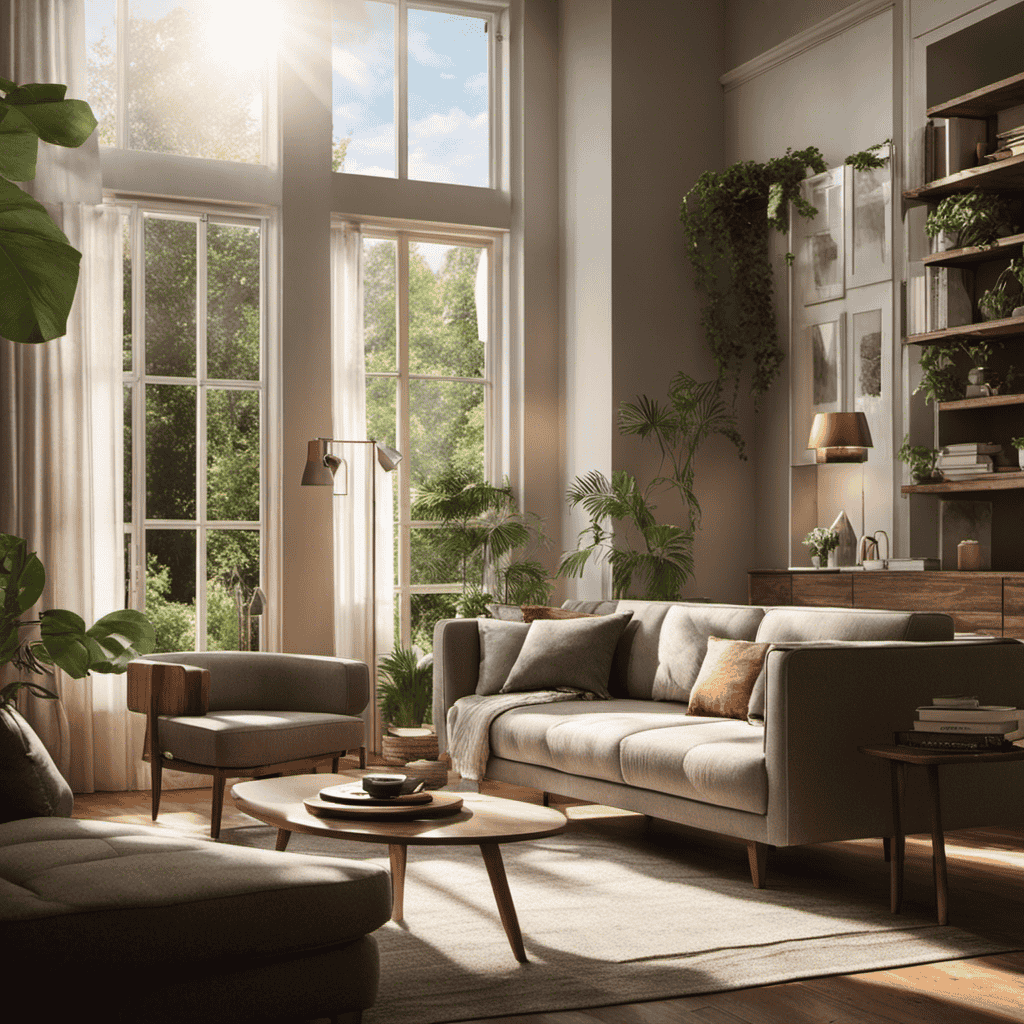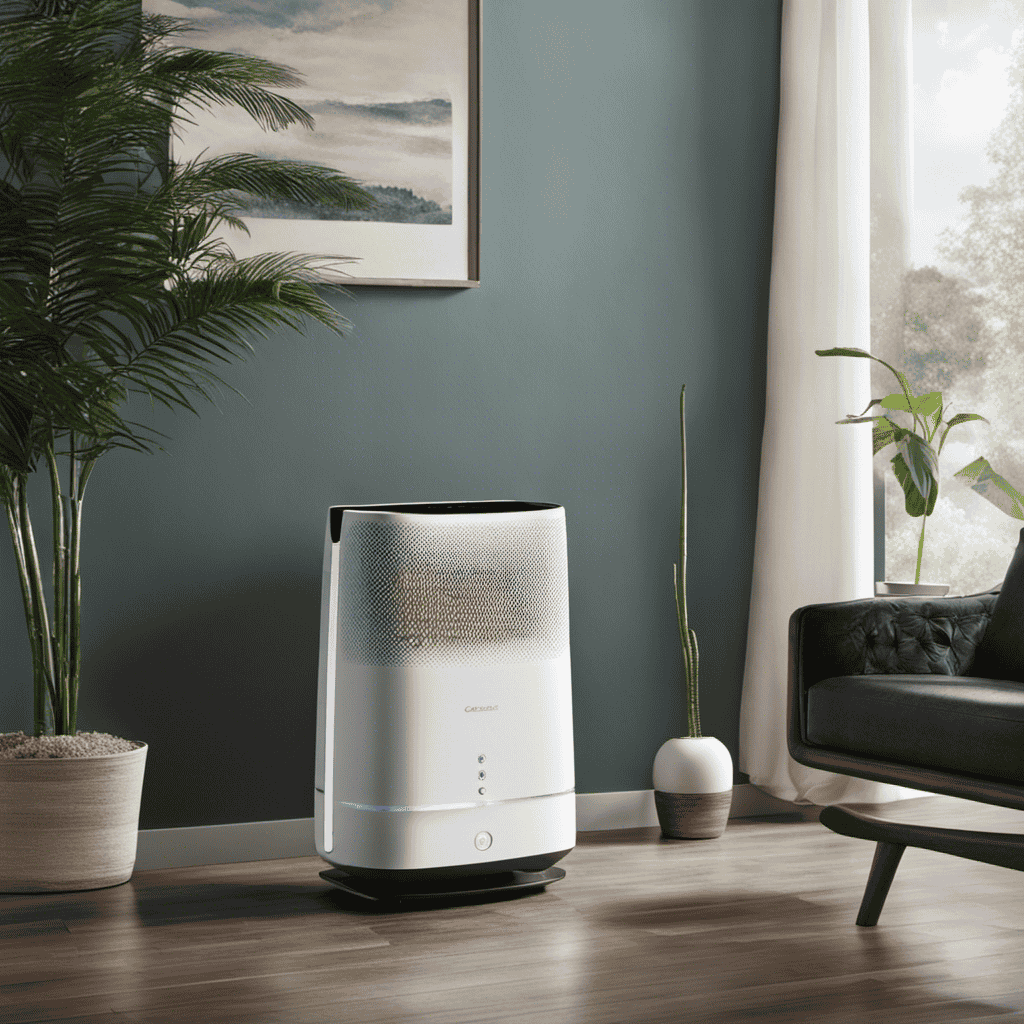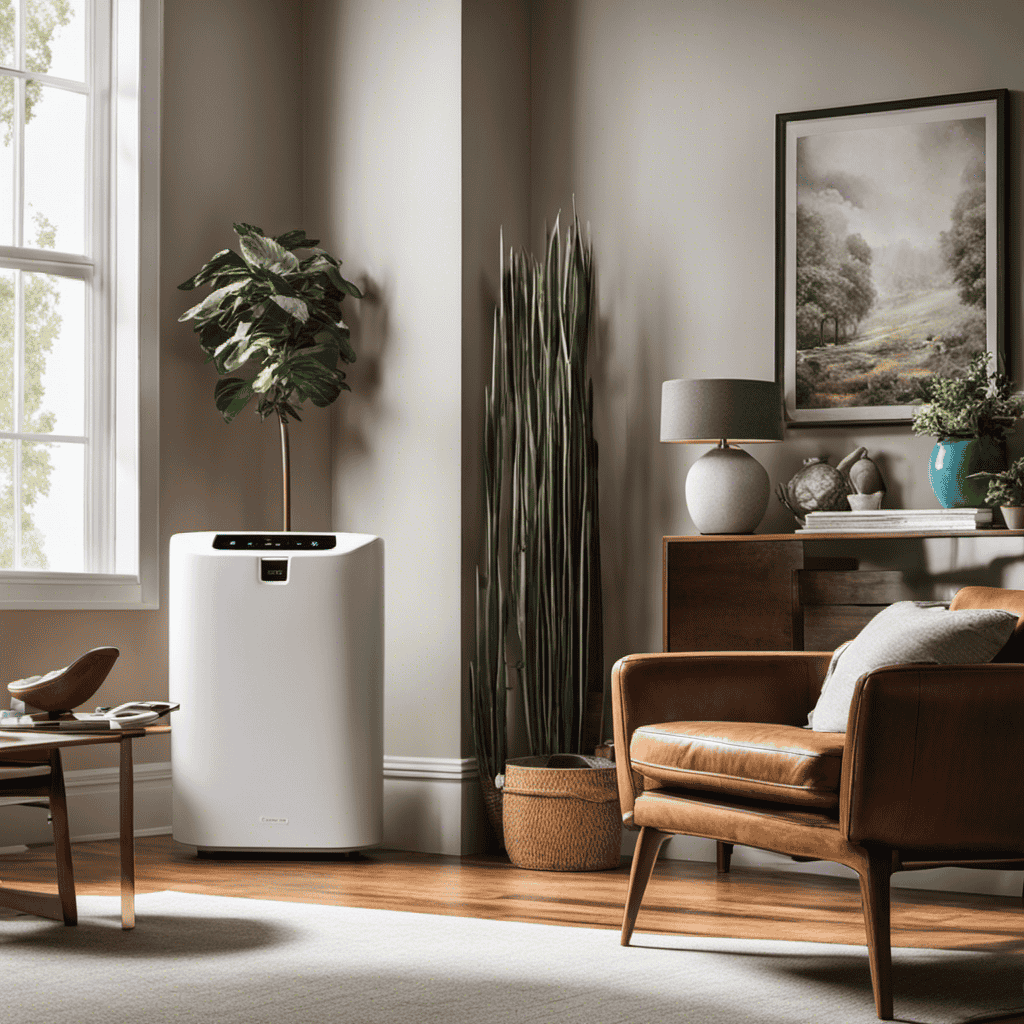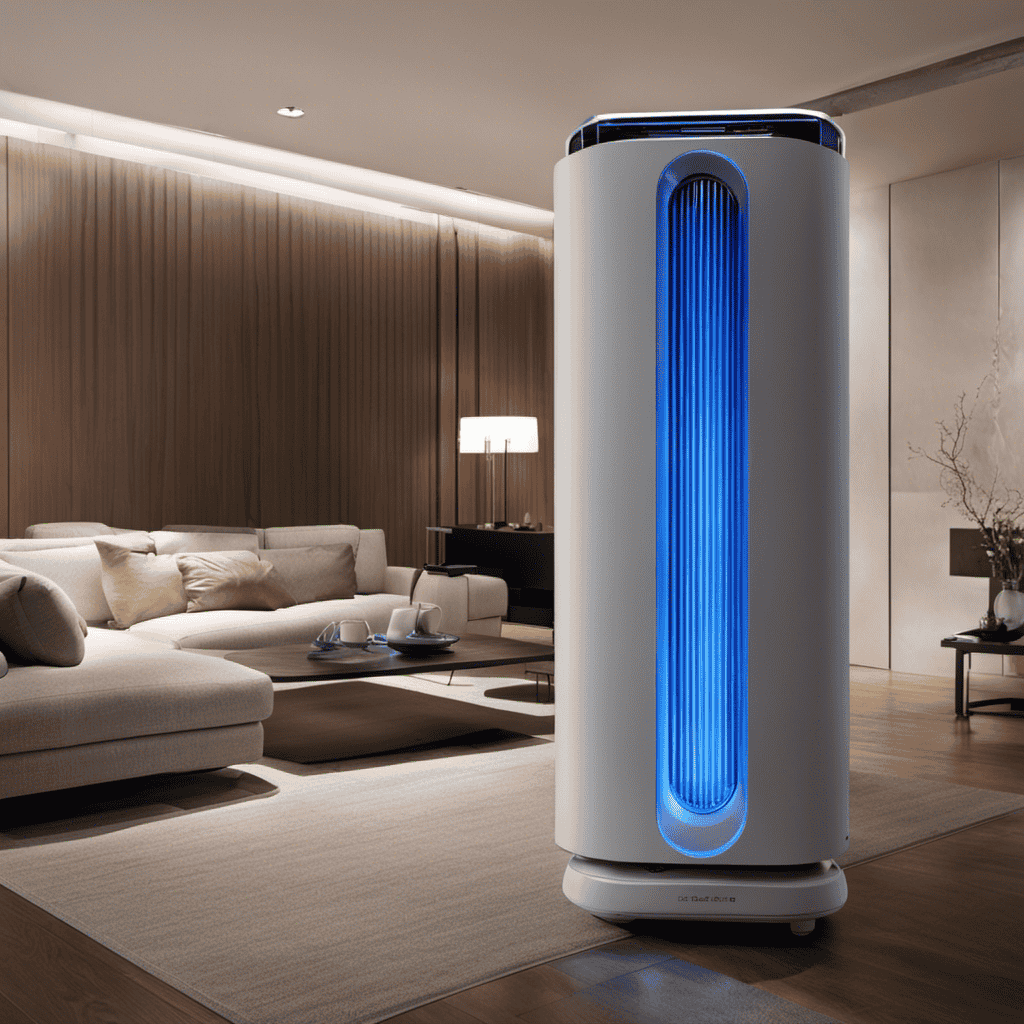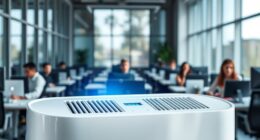I’m not an authority on the subject, but when it concerns the air I inhale, I want to ensure it is clean and healthy. This led me to ponder whether I should invest in an air purifier.
In this article, we’ll dive into the world of indoor air quality and explore the common pollutants that could be lurking in our homes. We’ll also discuss the potential health effects of poor air quality and the symptoms to watch out for.
So, let’s clear the air and find out if an air purifier is right for you.
Key Takeaways
- Indoor air pollutants such as dust, pollen, pet dander, mold spores, VOCs, carbon monoxide, and radon can impact respiratory health.
- Symptoms of air pollution include coughing, wheezing, shortness of breath, and irritation of the eyes, nose, and throat.
- Clean air reduces the risk of respiratory problems, allergies, and lung infections, and promotes better cardiovascular health and cognitive function.
- Factors to consider when choosing an air purifier include room size, filtration system, noise level, maintenance, and effectiveness.
Understanding Indoor Air Quality
You should be aware of the current indoor air quality in your home. Indoor air pollutants can have a significant impact on respiratory health, so it is crucial to understand the quality of the air you breathe.
Common indoor air pollutants include dust, pollen, pet dander, mold spores, and volatile organic compounds (VOCs) emitted by cleaning products or furniture. These pollutants can cause or worsen respiratory conditions such as asthma, allergies, and chronic obstructive pulmonary disease (COPD).
To assess your indoor air quality, you can use an air quality monitor or consult with a professional. Regularly cleaning and ventilating your home, using air purifiers, and minimizing the use of chemical-based products can help improve indoor air quality and protect your respiratory health.
Common Indoor Air Pollutants
Identifying common indoor air pollutants can help you determine whether an air purifier is necessary. There are several sources of contamination that contribute to poor indoor air quality. These pollutants can originate from both outdoor and indoor sources, and can pose a risk to our health if not properly addressed. To give you a better understanding, here’s a table outlining some common indoor air pollutants and their sources:
| Indoor Air Pollutant | Sources of Contamination |
|---|---|
| Volatile Organic Compounds (VOCs) | Paints, cleaning products, furniture, carpets |
| Particulate Matter | Dust, pollen, pet dander, tobacco smoke |
| Mold and Mildew | Damp areas, leaks, high humidity |
| Carbon Monoxide | Gas appliances, wood-burning stoves |
| Radon | Soil, building materials, well water |
Knowing the sources of these pollutants can help you determine if an air purifier is necessary. However, it’s important to note that the effectiveness of air purifiers varies depending on the type and size of the pollutant. Consulting with an indoor air quality professional can provide you with more specific guidance on whether an air purifier is the right solution for your needs.
Health Effects of Poor Air Quality
When it comes to discussing the health effects of poor air quality, three key points to consider are:
-
Symptoms of air pollution can vary from person to person but may include coughing, wheezing, shortness of breath, and irritation of the eyes, nose, and throat.
-
Long-term exposure to polluted air has been linked to an increased risk of respiratory diseases, cardiovascular problems, and even premature death.
-
On the other hand, clean air provides numerous benefits to our health, including improved lung function, reduced risk of respiratory infections, and better overall well-being.
Symptoms of Air Pollution
There’s no denying that air pollution can have a significant impact on our health. The signs and symptoms of air pollution are varied and can affect different individuals in different ways. Here are some common signs and symptoms that may indicate exposure to air pollution:
| Signs and Symptoms | Description |
|---|---|
| Coughing | Persistent cough or throat irritation |
| Shortness of breath | Difficulty breathing or feeling of breathlessness |
| Wheezing | Whistling sound while breathing |
| Chest tightness | Feeling of pressure or discomfort in the chest |
| Fatigue | Excessive tiredness or lack of energy |
| Headaches | Persistent or recurring headaches |
These symptoms may worsen for individuals with pre-existing respiratory conditions such as asthma or chronic obstructive pulmonary disease (COPD). If you experience any of these symptoms, particularly when you are exposed to high levels of air pollution, it is important to consult a healthcare professional for proper diagnosis and advice.
Long-Term Health Risks
Exposure to air pollution over a long period of time can lead to various health risks. Research has shown that long-term exposure to air pollution is associated with an increased risk of respiratory diseases such as asthma, chronic obstructive pulmonary disease (COPD), and lung cancer. Additionally, it can also contribute to heart diseases, stroke, and even premature death.
The harmful effects of air pollution are primarily due to the presence of pollutants such as particulate matter, nitrogen dioxide, and ozone. These pollutants can irritate the respiratory system, cause inflammation, and damage lung tissues.
To mitigate these risks, it is important to take preventative measures such as reducing exposure to outdoor air pollution by staying indoors during peak pollution times, using air purifiers, and wearing masks when necessary. Regular physical exercise and maintaining a healthy lifestyle can also help in reducing the impact of long-term air pollution on our health.
Benefits of Clean Air
Breathing clean air can have numerous benefits for our overall health and well-being. The importance of air purification cannot be overstated, as it helps to remove harmful pollutants and improve the quality of the air we breathe. Clean air benefits us in many ways, both physically and mentally.
Physically, clean air reduces the risk of respiratory problems such as asthma, allergies, and lung infections. It also promotes better cardiovascular health, as air pollution has been linked to an increased risk of heart disease. Mentally, breathing clean air can improve cognitive function and enhance mood, leading to a greater sense of well-being.
To highlight the benefits of clean air, let’s take a look at the following table:
| Physical Benefits | Mental Benefits |
|---|---|
| Reduces respiratory problems | Improves cognitive function |
| Promotes better cardiovascular health | Enhances mood |
| Decreases the risk of lung infections | Increases overall sense of well-being |
| Reduces the risk of allergies and asthma |
As you can see, clean air has a wide range of benefits for our health and well-being. By investing in air purification systems, we can ensure that we are breathing in clean and pollutant-free air, reaping the rewards for our physical and mental health.
Symptoms of Poor Indoor Air Quality
When it comes to discussing the impact of poor indoor air quality on our health, there are several key points to consider.
First and foremost, common health issues can arise from exposure to pollutants in the air we breathe. These can include respiratory problems, allergies, and asthma.
Additionally, it’s important to be aware of the various triggers that can worsen these conditions, such as dust mites, pet dander, mold, and pollen. These triggers can have a significant impact on our respiratory system, leading to symptoms like coughing, wheezing, shortness of breath, and even asthma attacks.
Common Health Issues
If you’re experiencing symptoms like coughing or sneezing, it might be worth considering an air purifier. Allergies can be a major nuisance and can greatly affect your respiratory health.
Air purifiers are designed to remove common allergens from the air, such as pollen, dust mites, pet dander, and mold spores. By eliminating these allergens, air purifiers can help prevent allergic reactions and improve overall respiratory health.
Studies have shown that using air purifiers can significantly reduce symptoms of allergies, such as sneezing, itching, and congestion. They can also be beneficial for individuals with asthma, as they can help remove triggers that can cause asthma attacks.
Investing in an air purifier can be a proactive step in maintaining a clean and allergen-free indoor environment, promoting better respiratory health.
Allergy and Asthma Triggers
Using an air purifier can effectively reduce common allergens in the air, helping to prevent allergic reactions and improve respiratory health. Here are four reasons why air purifiers are effective for allergy prevention:
-
Filters out allergens: Air purifiers use filters to trap allergens like pollen, dust mites, pet dander, and mold spores, preventing them from circulating in the air.
-
Removes airborne irritants: Air purifiers also capture irritants such as smoke, VOCs, and odors, providing relief for individuals with sensitivities or respiratory conditions.
-
Improves indoor air quality: By continuously filtering the air, air purifiers can significantly reduce the concentration of allergens and other pollutants, creating a healthier living environment.
-
Enhances respiratory health: With cleaner air, individuals are less likely to experience allergy symptoms, such as sneezing, coughing, and wheezing, leading to improved respiratory health.
Using an air purifier can make a noticeable difference in reducing allergy triggers and improving overall respiratory well-being. Now, let’s explore the specific impact of air purifiers on the respiratory system.
Impact on Respiratory System
Air purifiers can help individuals breathe easier by reducing the concentration of allergens and other pollutants in the air. Our respiratory health is greatly affected by air pollution, which can lead to a range of respiratory issues such as asthma, bronchitis, and even lung cancer. The harmful effects of air pollution on our respiratory system are well-documented and supported by scientific evidence. Exposure to pollutants like particulate matter, ozone, and nitrogen dioxide can cause inflammation in the airways, making it difficult to breathe. In fact, studies have shown that long-term exposure to air pollution can accelerate the decline in lung function and increase the risk of respiratory diseases. By using an air purifier, you can effectively remove these pollutants from the air and improve your respiratory health.
| Pollutant | Health Effects | Sources |
|---|---|---|
| Particulate Matter | Respiratory irritation, reduced lung function | Vehicle emissions, industrial processes |
| Ozone | Coughing, throat irritation, worsen asthma symptoms | Vehicle emissions, chemical reactions |
| Nitrogen Dioxide | Increased risk of respiratory infections | Vehicle emissions, fossil fuel combustion |
Sources of Indoor Air Pollution
You can identify potential sources of indoor air pollution by checking for common culprits like tobacco smoke, cleaning products, and mold.
Here are four other sources of pollutants that can contribute to poor indoor air quality:
-
Volatile Organic Compounds (VOCs): These are chemicals found in many household products, such as paints, solvents, and air fresheners. They can emit harmful gases into the air, leading to respiratory problems and other health issues.
-
Dust and pet dander: Dust can contain tiny particles from various sources, including dirt, pollen, and skin flakes. Pet dander, which is made up of microscopic skin cells shed by animals, can also trigger allergies and asthma symptoms.
-
Radon gas: This colorless and odorless gas can seep into homes through cracks in the foundation. Long-term exposure to high levels of radon can increase the risk of lung cancer.
-
Carbon monoxide: This toxic gas is produced by the incomplete combustion of fuels like gas, oil, and wood. Breathing in carbon monoxide can lead to headaches, dizziness, and even death in severe cases.
Reducing indoor air pollution involves taking steps to eliminate or minimize these sources. By addressing these common culprits, you can create a healthier environment for yourself and your family.
Now, let’s move on to assessing your indoor air quality.
Assessing Your Indoor Air Quality
When it comes to assessing our indoor air quality, it’s important to understand the common pollutants that can be present in our homes. These pollutants can come from a variety of sources, including cleaning products, tobacco smoke, and even our own activities like cooking.
Exposure to these pollutants can lead to a range of health risks, such as respiratory problems, allergies, and even certain types of cancer.
Common Indoor Air Pollutants
If your home has excessive dust, pet dander, or cigarette smoke, it may be a good idea to consider an air purifier. These common indoor air pollutants can have significant health effects, particularly on the respiratory system. Here are four reasons why an air purifier can help improve your indoor air quality and protect your health:
-
Removal of airborne particles: Air purifiers are designed to capture and filter out tiny particles like dust, pollen, and pet dander, reducing your exposure to allergens and irritants.
-
Reduction of odors: Air purifiers equipped with activated carbon filters can effectively remove odors from cigarette smoke, cooking, or pets, making your home smell fresher and cleaner.
-
Elimination of harmful chemicals: Some air purifiers are equipped with specialized filters that can remove volatile organic compounds (VOCs), which are chemicals found in household products and can cause respiratory irritation and other health problems.
-
Prevention of respiratory infections: Air purifiers can help remove airborne viruses and bacteria, reducing your risk of developing respiratory infections.
By investing in an air purifier, you can create a healthier indoor environment and minimize the health risks associated with poor air quality.
[Transition sentence into the subsequent section about ‘health risks associated’]Additionally, understanding the potential health risks associated with these indoor air pollutants is crucial for making informed decisions about your indoor air quality.
Health Risks Associated
Understanding the potential health risks associated with indoor air pollutants is crucial for protecting your well-being and making informed decisions about improving indoor air quality.
Air pollution can have a wide range of negative effects on health. For example, exposure to particulate matter, such as dust, pollen, and pet dander, can trigger allergies and asthma attacks.
Volatile organic compounds (VOCs) emitted by cleaning products, paints, and furniture can cause headaches, dizziness, and respiratory irritation.
Additionally, indoor air pollution has been linked to the development and exacerbation of respiratory conditions, cardiovascular diseases, and even cancer.
It is important to be aware of these health risks and take steps to reduce them. This can include using air purifiers, improving ventilation, and avoiding or minimizing the use of potential sources of indoor air pollution.
Factors to Consider Before Purchasing an Air Purifier
Before purchasing an air purifier, you should consider factors such as the size of your living space and any specific allergens you may need to target. Here are a few important factors to keep in mind:
-
Room size: It’s essential to choose an air purifier that is suitable for the size of your room. A larger room may require a more powerful purifier to effectively clean the air.
-
Filtration system: Look for an air purifier with a high-quality filtration system that can capture small particles, including allergens like dust, pollen, and pet dander.
-
Noise level: Consider the noise level of the air purifier, especially if you plan to use it in a bedroom or office space where quietness is important.
-
Maintenance and filter replacement: Check the manufacturer’s recommendations for filter replacement and maintenance to ensure that the air purifier remains efficient.
Considering these factors will help you choose the right air purifier to address your indoor allergies and enjoy the benefits of cleaner, healthier air.
Benefits of Using an Air Purifier
Before making the decision to purchase an air purifier, it is important to understand the benefits it can provide.
Air purifiers are designed to improve indoor air quality by removing contaminants and allergens from the air we breathe. They can be particularly beneficial for individuals with respiratory conditions, allergies, or sensitivities to pollutants.
Air purifiers work by using various air purification technologies to filter out harmful particles and pollutants. Some common technologies include HEPA filters, activated carbon filters, and ionizers. These technologies are designed to capture and eliminate airborne particles such as dust, pollen, pet dander, smoke, and even bacteria and viruses.
Studies have shown that air purifiers can be effective in reducing indoor air pollution and improving overall air quality. However, it is important to note that the effectiveness of an air purifier may vary depending on factors such as the size of the room, the type of pollutants present, and the specific model of the purifier.
Understanding the benefits and effectiveness of air purifiers is crucial in determining whether you need one in your home. Now, let’s explore the different types of air purifiers available in the market.
Types of Air Purifiers
There are various types of air purifiers available in the market. When choosing an air purifier, it’s important to consider your specific needs and preferences.
Here are some popular types of air purifiers and their features:
-
HEPA Air Purifiers: These purifiers use high-efficiency particulate air (HEPA) filters to trap small particles like dust, pollen, and pet dander. They are highly effective in removing allergens from the air, making them ideal for allergy sufferers.
-
Activated Carbon Air Purifiers: These purifiers have activated carbon filters that can remove odors, smoke, and harmful gases from the air. They are great for eliminating unpleasant smells and improving indoor air quality.
-
UV-C Air Purifiers: These purifiers use ultraviolet (UV) light to kill bacteria, viruses, and mold spores in the air. They are beneficial for people with respiratory conditions or those concerned about airborne pathogens.
-
Ionic Air Purifiers: These purifiers release negative ions into the air, which attach to particles and make them heavy, causing them to fall to the ground. They are effective in removing airborne allergens and pollutants.
Overall, air purifiers with HEPA filters provide multiple benefits, including the removal of allergens and improving indoor air quality. Consider your specific needs and choose the type of air purifier that best suits you.
Choosing the Right Air Purifier for Your Needs
When it comes to choosing the right air purifier for your needs, there are a few key points to consider.
First, it’s important to understand the air quality indicators in your space, such as pollen, dust, or pet dander, in order to determine the level of filtration required.
Second, targeted purification options, such as HEPA filters for allergens or activated carbon filters for odors, can be tailored to address specific concerns.
Lastly, size and space considerations should be taken into account to ensure the air purifier fits appropriately and effectively circulates clean air throughout the room.
Air Quality Indicators
One way to determine if you need an air purifier is by monitoring the air quality indicators in your home. These indicators can give you valuable information about the presence of indoor air pollution sources and help you make an informed decision about whether or not to invest in an air purifier.
Here are four key air quality indicators to consider:
-
Particulate Matter (PM): This includes dust, pollen, pet dander, and other microscopic particles suspended in the air. High levels of PM can trigger allergies and respiratory issues.
-
Volatile Organic Compounds (VOCs): These are chemicals emitted by household products such as cleaning agents, paints, and furniture. High levels of VOCs can cause headaches, dizziness, and even long-term health effects.
-
Carbon Dioxide (CO2): Elevated CO2 levels can indicate poor ventilation and may lead to drowsiness, poor concentration, and discomfort.
-
Relative Humidity: Excess moisture in the air can promote the growth of mold and mildew, leading to respiratory problems and allergic reactions.
Targeted Purification Options
Consider investing in targeted purification options to address specific air quality concerns in your home. While traditional air purifiers can improve overall air quality, targeted purification methods offer additional benefits by focusing on specific pollutants or allergens. These methods use specialized filters or technologies to effectively remove specific contaminants from the air.
Below is a table highlighting three common targeted purification methods and their benefits:
| Targeted Purification Method | Benefits |
|---|---|
| HEPA Filters | Removes 99.97% of particles as small as 0.3 microns, including dust, pollen, and pet dander. |
| Activated Carbon Filters | Absorbs odors, gases, and chemical pollutants like smoke and volatile organic compounds (VOCs). |
| UV-C Light Technology | Kills bacteria, viruses, and mold spores by damaging their DNA and preventing reproduction. |
Size and Space Considerations
When considering buying an air purifier, it’s important to take into account the size of the purifier and the space in your room. Here are some key considerations:
-
Room size: Measure the square footage of the room where you plan to use the air purifier. Different purifiers have varying coverage areas, so choose one that can effectively clean the air in your specific room size.
-
CADR rating: Look for the Clean Air Delivery Rate (CADR) of the air purifier. This rating indicates how efficiently the purifier can remove pollutants from the air. Higher CADR ratings are recommended for larger rooms.
-
Portability: Consider the size and weight of the air purifier. If you plan to move it between rooms frequently, a compact and lightweight option may be more convenient.
-
Placement options: Determine where you can place the air purifier in your room. Consider factors like available floor space, furniture layout, and electrical outlets.
How Air Purifiers Work
Air purifiers work by filtering out pollutants and allergens from the air. Indoor air pollution can be a significant concern, as studies have shown that the air inside our homes can be more polluted than the air outside.
Common indoor pollutants include dust, pet dander, mold spores, and volatile organic compounds (VOCs) emitted from household products. Air purification technologies, such as HEPA filters, activated carbon filters, and UV-C light, help to remove these pollutants and improve the air quality in our homes.
HEPA filters are highly effective at capturing particles as small as 0.3 microns, while activated carbon filters can absorb odors and chemicals. UV-C light can kill bacteria and viruses.
Maintenance and Filter Replacement
Regular maintenance and filter replacement are essential to ensure that an air purifier continues to effectively remove pollutants and maintain good air quality. Here are some maintenance tips that can help prolong the life of your air purifier’s filter:
-
Clean the pre-filter: The pre-filter is the first line of defense against larger particles. Cleaning it regularly can prevent clogging and improve the overall efficiency of the air purifier.
-
Replace the filters on time: Different types of filters have different lifespans. It’s important to follow the manufacturer’s recommendations and replace the filters as instructed to maintain optimal performance.
-
Vacuum the exterior: Dust and debris can accumulate on the exterior of the air purifier. Regularly vacuuming the exterior can prevent these particles from entering the device and clogging the filters.
-
Keep the air purifier in a clean environment: Placing the air purifier in a clean area can reduce the amount of pollutants it needs to filter, thereby prolonging the life of the filters.
Cost Considerations of Air Purifiers
One important factor to consider when purchasing an air purifier is the cost of replacement filters. These filters play a crucial role in maintaining the effectiveness of the air purifier, as they trap and remove pollutants from the air. Different air purifier brands have varying costs for replacement filters, so it’s essential to research and compare prices before making a decision. Additionally, it’s worth considering the energy efficiency of the air purifier. Look for models that are Energy Star certified, as they are designed to use less power and save on electricity bills. To help visualize the cost considerations of air purifiers, here is a table comparing the prices of replacement filters for three popular brands:
| Air Purifier Brand | Average Replacement Filter Cost |
|---|---|
| Brand A | $20 |
| Brand B | $30 |
| Brand C | $25 |
Considering both the cost of replacement filters and the energy efficiency of the air purifier can help you make an informed decision and find the best option for your needs and budget.
Other Strategies for Improving Indoor Air Quality
To enhance the quality of air in your home, consider utilizing alternative methods such as keeping indoor plants, using natural cleaning products, and opening windows for ventilation. These strategies can help improve the ventilation in your home and act as natural air purifiers.
Here are four ways you can improve the air quality in your home:
-
Indoor Plants: Certain plants, like snake plants and peace lilies, have air-purifying properties and can help remove toxins from the air.
-
Natural Cleaning Products: Avoid using harsh chemicals and opt for natural cleaning products, like vinegar and baking soda, which are safer for both your health and the environment.
-
Open Windows: Regularly opening windows allows fresh air to circulate, removing stale air and potentially harmful pollutants.
-
Air Filters: Use high-quality air filters in your HVAC system to trap dust, pollen, and other particles, improving the overall air quality in your home.
Consulting an Expert: When to Seek Professional Advice
If you want to ensure that you’re making the right decisions for improving your indoor air quality, it’s a good idea to consult with an expert who can provide professional advice tailored to your specific needs.
Seeking professional guidance can be beneficial in many ways. An expert will have the knowledge and experience to assess your indoor environment and identify potential sources of air pollution. They can recommend appropriate measures to improve air quality, such as the installation of air purifiers or the implementation of ventilation systems.
Additionally, they can provide insights on other strategies that may be necessary, such as proper maintenance of HVAC systems or the use of natural cleaning products.
Frequently Asked Questions
How Often Should I Replace the Filters in My Air Purifier?
I replace the filters in my air purifier every 3-6 months. Signs of a dirty air filter include reduced airflow and increased dust accumulation. Regular filter replacement ensures optimal performance and cleaner air.
Can an Air Purifier Eliminate All Types of Indoor Air Pollutants?
An air purifier can effectively eliminate a wide range of indoor air pollutants, improving the quality of the air we breathe. It acts as a shield, capturing and removing harmful particles, creating a healthier environment.
Are There Any Potential Health Risks Associated With Using an Air Purifier?
I want to mention that there are potential side effects and long-term effects associated with using an air purifier. It is important to be informed about these risks before deciding if an air purifier is necessary for you.
Can an Air Purifier Help With Reducing Household Odors?
Yes, an air purifier can help reduce household odors. In fact, studies have shown that they can effectively remove common odors like cooking smells and pet odors, making your home fresher and more pleasant.
How Much Electricity Does an Air Purifier Consume?
If you’re wondering about the electricity consumption of an air purifier, it’s important to consider its energy efficiency. Look for models with Energy Star certification, which are designed to use less electricity while still providing effective air purification.
What are the Signs that Indicate the Need for an Air Purifier?
When you notice frequent sneezing, coughing, or watery eyes indoors, it’s one of the air purifier necessity indicators. Additionally, lingering odors, visible dust, or mold in your home may call for an air purifier. If you’re experiencing these symptoms, it may be time to invest in an air purifier.
Conclusion
In conclusion, it is clear that an air purifier is a wise investment after delving into the realm of indoor air quality. These devices have the ability to combat common indoor pollutants, such as dust, pet dander, and mold spores. By doing so, they can significantly improve the air you breathe.
Don’t wait for the wolf to knock on your door; take action now and protect your health. Remember, when it comes to clean air, an air purifier is the key that unlocks a world of freshness and vitality.
